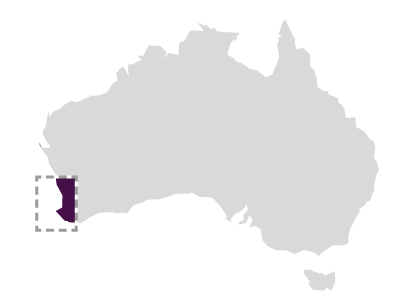Solglyt (1901/09/12)
Koombana Channel

Solglyt was built by M. Svensen in Grimstad, Norway, with one deck, two tiers of beams and had been sheathed with yellow metal. Described as being of shapely appearance, it was principally owned by Captain A. Rassmussen and his brother, and was insured. Captain Rasmussen was the master, with a crew of 13 and three passengers when it arrived in Koombana Bay from Port Natal on 18 May 1901. It loaded a cargo of jarrah for the Port Natal Harbour Board and the Port Natal Railway. This consisted of 10 935 pieces, including 81 piles 12.2–16.8 m long, plus sleepers and other timber. The cargo was shipped by George Baxter, who had gone to great lengths to select ‘the best samples ever shipped at this port’ (Bunbury Herald, 13 July 1901: 2a), and was valued at £2 500.
THE LOSS
The Solglyt was anchored with two anchors down preparatory to departing for South Africa. The weather was described as heavy with the wind blowing strongly from the north and north-east, accompanied by squalls and strong tides, which lasted nearly all day. Captain Rasmussen tried to kedge out to a heavy mooring buoy, but a squall struck and one of the anchor cables parted. During the afternoon the vessel was driven back, and finally grounded in shallow water, settling ‘across the reef on which the Agra was wrecked about five years ago’ (Bunbury Herald, 13 July 1901: 2a). It commenced to bump heavily and soon started to fill with water. At midnight a ‘tempestuous wind was blowing accompanied by heavy rains, and although distress lights were burnt nothing could be done to relieve the vessel, while the absence of a steam tug rendered the process of pulling her off quite out of the question’ (Bunbury Herald, 13 July 1901: 2a). The following day the vessel had completely filled, with water running over the starboard side. The stern of the barque was still bumping.
The Harbour Master, John George Abrahamson, wrote to the Chief Harbour Master at Fremantle, Captain Charles Russell:
I beg to state that early morning on the 10th instant…the Captain of the Norwegian barque Solglyt, in trying to haul his vessel out towards a heavy mooring buoy, to which he had run a line in preparing to go to sea, the vessel was caught with a sudden strong wind from N. to N.E. and drifted down towards the shallow water; he let go both anchors and hung on, but as the wind increased he dragged further in, at about 3.30 p.m. of the same day. Captain came ashore, informing me that his vessel was touching ground aft. I went out with two Norwegian shipmasters in my own boat. At about 9 p.m., in a terrific squall, vessel dragged her anchors further in, and was bumping heavily. Captain was paying out cable and reported 4 ft. of water in the hold… At about 2 a.m. on 12th (Friday), as the tide rose, she canted slightly with her stern to Eastward, and sank at her anchors in 20 ft. of water aft, 21.6 ft. forward and amidships at low water (Fremantle Harbour-Master’s Letterbook, 12 July 1901, quoted in Fall, 1972: 138).
On Friday 12 July 1901 the Lloyd’s surveyor, Captain Webster, arrived and, after inspection, pronounced the vessel a total wreck. The following day a diver was sent down to locate the exact position of the damage.
INITIAL SALVAGE
Some of the timber had been off loaded and lightered ashore before the Solglyt finally settled on the sea bed. On 18 July 1901 the wreck of the Solglyt ‘as she now lies submerged in Bunbury Harbour. All sails, gear, and boats on board, and on shore, at the same time the cargo of about 715 loads on board and 35 loads landed of jarrah timber, consisting of piles, timber, sleepers, etc.’ (Bunbury Herald, 16 July 1901: 3d) was sold by an auction. This was conducted on the Bunbury Jetty by James Moore. The sale realised £75 for the vessel and £125 for the cargo, being bought by Mr Rohr. Mr Jones paid £3 for the praam, Mr Orr £16 10s 0d for a double-ended lifeboat, Mr G. Hayward £5 for a jolly boat, and the longboat was sold to Captain Griffs for £8 15s 0d. Other items were sold at the Customs shed, the total from everything sold being £340. The timber already ashore had a lien on it of £60 payable to Messrs Millar Bros for lighterage, but no offer was made.
SITE LOCATION
The wreck of the Solglyt lies buried near the channel between Koombana Bay and the Leschenault Inlet. It was uncovered during excavations for that channel at Point McLeod in 1973. Badly damaged by the bulldozers, the remains were buried nearby.
EXCAVATION AND ARTEFACTS
For a while the bell from the Solglyt was hung at the Bunbury High School, but it was later stolen.
Ship Built
Owner O. R. Foreid
Master Captain A. Rasmussen
Builder M. Suensen
Country Built Norway
Port Registered Grimstad, Norway
When Built 1888
Ship Lost
Grouped Region South-West-Coast
Sinking Beached
Crew 13
When Lost 1901/09/12
Where Lost Koombana Channel
Latitude -33.320668
Longitude 115.641839
Position Information Chart
Port To Port Natal, South Africa
Cargo Jarrah
Ship Details
Engine N
Length 53.80
Beam 5.00
TONA 875.00
TONB 797.00
Draft 6.10
Museum Reference
Unique Number 1432
Sunk Code Wrecked and sunk
File Number 2010/0037/SG _MA-405/71
Chart Number AUS 334
Protected Not protected State
Found Y
Inspected Y
Confidential NO